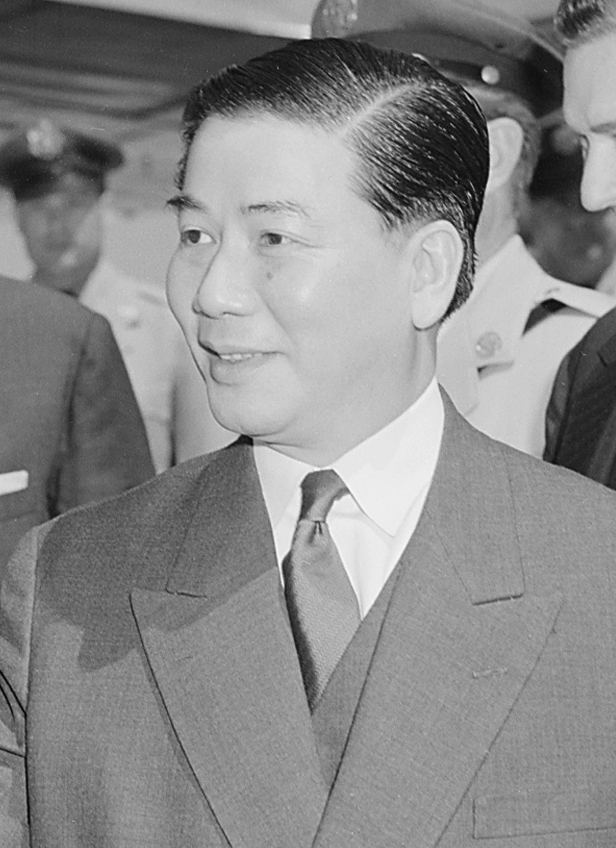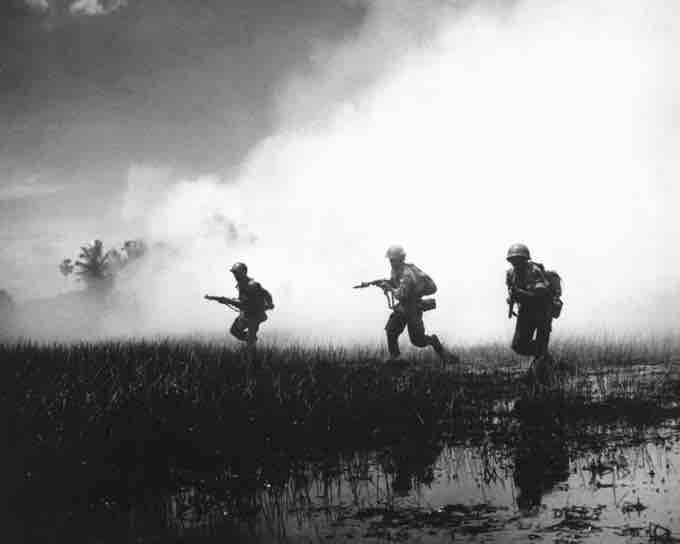Overview: The Vietnam War
The Vietnam War (1957–1975) was conducted in South Vietnam and the bordering areas of Cambodia, Laos, and North Vietnam. American advisors came in the late 1950s to help the Republic of Vietnam (RVN) in the South combat communist insurgents from the North under communist leader Ho Chi Minh, known as the Viet Cong. The U.S. framed the war as part of its policy of containment of communism in south Asia; however, the war was met with significant protests at home on American soil.
Background to the War
In South Vietnam, anti-Communist Ngo Dinh Diem had become prime minister in 1954, while Ho Chi Minh continued to rule the North. Realizing that Diem would never agree to the reunification of the country under Ho Chi Minh’s leadership, the North Vietnamese began efforts to overthrow the government of the South by encouraging insurgents to attack South Vietnamese officials. By 1960, North Vietnam had also created the National Liberation Front (NLF) to resist Diem and carry out an insurgency in the South.
The United States, fearing the spread of Communism under Ho Chi Minh, supported Diem, assuming he would create a democratic, pro-Western government in South Vietnam. However, Diem’s oppressive and corrupt government made him a very unpopular ruler, particularly with farmers, students, and Buddhists, and many in the South actively assisted the NLF and North Vietnam in trying to overthrow his government.
Growing Involvement and the Policy of Containment
When Kennedy took office, Diem’s government was faltering. The Kennedy administration remained essentially committed to the Cold War foreign policy of containment practiced by the Truman and Eisenhower administrations. In 1961, Kennedy faced three events that made it appear as if the U.S. was bending to communism: the failure of the Bay of Pigs Invasion, the construction of the Berlin Wall, and communist political movement in Laos, called Pathet Lao, which received Soviet support in 1961. Ultimately, Kennedy proposed a plan for a neutral Laos that the Soviet Union endorsed. After this agreement, Kennedy believed that another failure to gain control and stop communist expansion would fatally damage U.S. credibility with its allies and dominance as a world superpower.
In March of 1961, when Kennedy voiced a change in policy from supporting a "free" Laos to a "neutral" Laos, he implied Vietnam, not Laos, would be deemed America's tripwire for communist spread in Southeast Asia. Kennedy was determined to "draw a line in the sand" and prevent a communist victory in Vietnam. In May of 1961, Kennedy dispatched Lyndon Johnson to meet with South Vietnam's President Diem. Johnson assured Diem that the US would provide more aid that could be used to mold a fighting force that could resist the communists. Kennedy announced a change of policy from support to partnership with Diem in order to defeat communism in South Vietnam.
Troops Under Kennedy
Continuing the policies of the Eisenhower administration, Kennedy supplied Diem with money and military advisors to prop up his government. In May of 1961, Kennedy sent 400 United States Army Special Forces personnel to South Vietnam to train South Vietnamese soldiers. By the end of 1961, the American advisers in Vietnam numbered 3,205. In February of 1962, Kennedy created The Military Assistance Command Vietnam (MACV), and in August of 1962, Kennedy signed the Foreign Assistance Act of 1962, which provides "…military assistance to countries...on the rim of the Communist world and under direct attack." By November of 1963, there were over 16,000 U.S. troops in Vietnam, training members of that country’s special forces and flying air missions that dumped defoliant chemicals on the countryside to expose North Vietnamese and NLF forces and supply routes.
Kennedy's policy toward South Vietnam rested on the assumption that South Vietnamese leader Diem and his forces must ultimately defeat the North Vietnamese troops on their own. He was against the deployment of American combat troops and observed that "to introduce U.S. forces in large numbers there today, while it might have an initially favorable military impact, would almost certainly lead to adverse political and, in the long run, adverse military consequences." The quality of the South Vietnamese military (ARVN), however, remained weak.
Diem's Assassination
A few weeks before Kennedy’s own death, Diem and his brother Nhu were assassinated by South Vietnamese military officers after U.S. officials had indicated their support for a new regime. After Diem's assassination, South Vietnam entered a period of extreme political instability, as one military government toppled another in quick succession. Increasingly, each new regime was viewed as a puppet of the Americans. The Viet Cong and communist insurgencies in South Vietnam took advantage of this instability and increased their strength. By this point, U.S. military advisers were embedded at every level of the South Vietnamese armed forces. General Paul Harkins, the commander of U.S. forces in South Vietnam, confidently predicted victory against the insurgents by Christmas of 1963. The CIA was less optimistic, however, warning that "the Viet Cong by and large retain de facto control of much of the countryside and have steadily increased the overall intensity of the effort."

South Vietnam President
President Ngo Dinh Diem of South Vietnam.
Kennedy's Assassination
At the time of Kennedy's death, no firm policy decision had been made regarding Vietnam. U.S. involvement in the region escalated until Lyndon Johnson deployed regular U.S. military forces for fighting the Vietnam War. After Kennedy's assassination, President Johnson passed a memorandum that reversed Kennedy's decision to withdraw 1,000 troops and instead reaffirmed the policy of assistance to the South Vietnamese. Major American military involvement began in 1964, when Congress provided President Johnson with blanket approval for presidential use of force in the Gulf of Tonkin Resolution.

South Vietnamese Troops
Operations against communist Viet Cong in Vietnam.